Challenge 2 -Task 1
In deploying a new application, a cloud customer needs to reflect different security postures. If a security zone is enabled with the Maximum Security Zone recipe, the customer will be unable to create or update a resource in the security zone if the action violates the attached Maximum Security Zone policy.
As an application requirement, the customer requires a compute instance in the public subnet. You therefore, need to configure Custom Security Zones that allow the creation of compute instances in the public subnet.
Review the architecture diagram, which outlines the resoures you'll need to address the requirement:
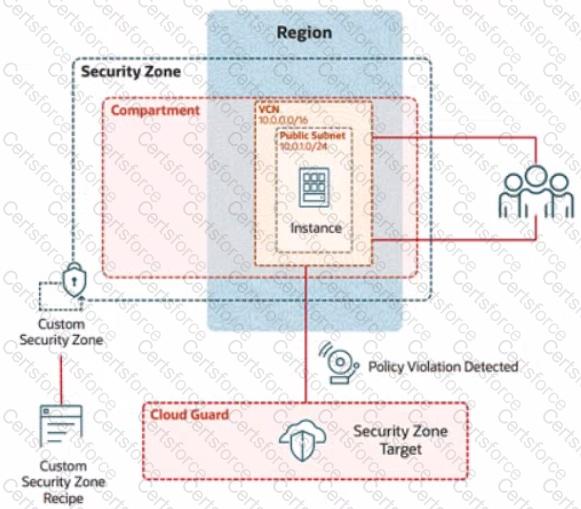
Preconfigured
To complete this requirement, you are provided with the following:
Access to an OCI tenancy, an assigned compartment, and OCI credentials
Required IAM policies
Task 2: Create a Security Zone
Create a security Zone named IAD_SAP-PBT-CSZ-01 in your assigned compartement and associate it with the Custom Security Zone Recipe (IAD-SAP-PBT-CSP-01) created in the previous task.
Enter the OCID of the created Security zone in the box below.

Challenge 2
In deploying a new application, a cloud customer needs to reflect different security postures. If a security zone is enabled with the Maximum Security Zone recipe, the customer will be unable to create or update a resource in the security zone if the action violates the attached Maximum Security Zone policy.
As an application requirement, the customer requires a compute instance in the public subnet. You therefore, need to configure Custom Security Zones that allow the creation of compute instances in the public subnet.
Review the architecture diagram, which outlines the resoures you'll need to address the requirement:
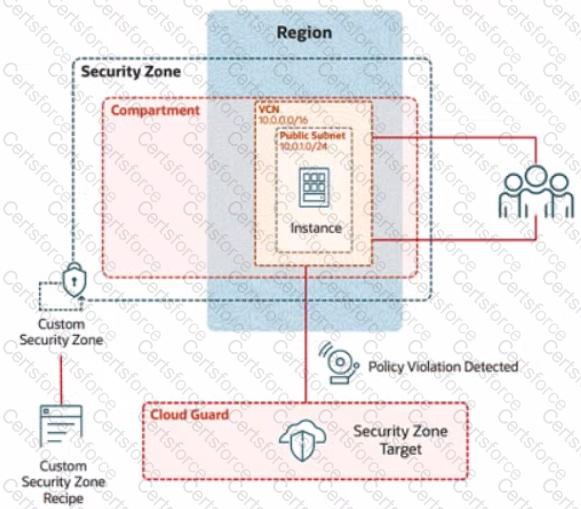
Preconfigured
To complete this requirement, you are provided with the following:
Access to an OCI tenancy, an assigned compartment, and OCI credentials
Required IAM policies
Task 5: Provision a Compute Instance
Provision a compute instance in the IAD-SP-PBT-PUBSNET-01 public subnet, where:
Name IAD-SP-PBT-1-VM-01
image: Oracle Linux 8
Shape VM: Standard, A1, Flex
Enter the OCID of the created compute instance in the text box below.
Challenge 2 -Task 1
In deploying a new application, a cloud customer needs to reflect different security postures. If a security zone is enabled with the Maximum Security Zone recipe, the customer will be unable to create or update a resource in the security zone if the action violates the attached Maximum Security Zone policy.
As an application requirement, the customer requires a compute instance in the public subnet. You therefore, need to configure Custom Security Zones that allow the creation of compute instances in the public subnet.
Review the architecture diagram, which outlines the resoures you'll need to address the requirement:
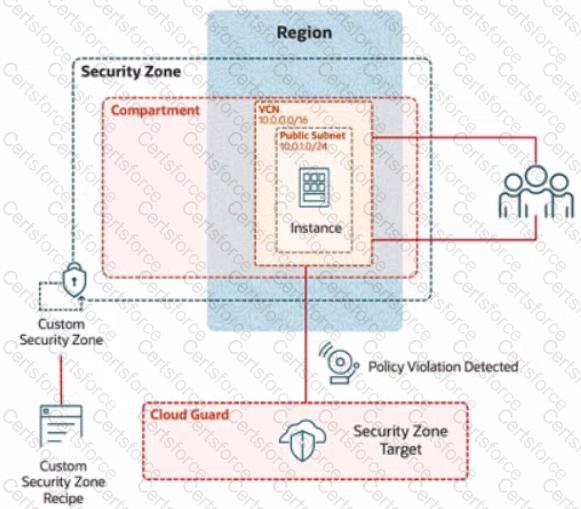
Preconfigured
To complete this requirement, you are provided with the following:
Access to an OCI tenancy, an assigned compartment, and OCI credentials
Required IAM policies
Task3: Create and configure a Virtual Cloud Network and Private Subnet
Createand configure virtual cloud Network (VCN) named IAD SP-PBT-VCN-01, with an internet Gateway and configure appropriate route rules to allow external connectivity.
Enter the OCID of the created VCN in the text box below.
Task 7: Verify the OCI Certificate with Load Balancer
Verify HTTPS connection to the load balancer by running the following command in Cloud Shell
curl -k https://
Enter the following URL in the web browser:
https://
If prompted with a certificate error, accept the risk and continue.
Verify web page content by ensuring the text, "You are visiting Web Server 1" from the index.html file is displayed in the browser
Challenge 1 - Task 1
Integrate TLS Certificate Issued by the OCI Certificates Service with Load Balancer
You are a cloud engineer at a tech company that is migrating its services to Oracle Cloud Infrastructure (OCI). You are required to set up secure communication for your web application using OCI's Certificate service. You need to create a Certificate Authority (CA), issue a TLS/SSL server certificate, and configure a load balancer to use this certificate to ensure encrypted traffic between clients and the backend servers.
Review the architecture diagram, which outlines the resources you'll need to address the requirement.
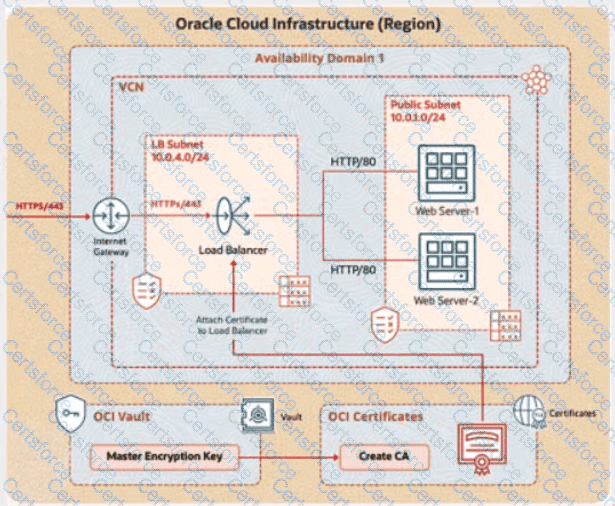
Preconfigured
To complete this requirement, you are provided with the following:
Access to an OCI tenancy, an assigned compartment, and OCI credentials
Required IAM policies
OCI Vault to store the secret required by the program, which is created in the root compartment as PBI_Vault_SP
Task 1: Create and Configure a Virtual Cloud Network (VCN)
Create a Virtual Cloud Network (VCN) namedPBT-CERT-VCN-01with the following specifications:
VCN with a CIDR block of 10.0.0.0/16
Subnet 1 (Compute Instance):
Name:Compute-Subnet-PBT-CERT
CIDR Block:10.0.1.0/24
Subnet 2 (Load Balancer):
Name:LB-Subnet-PBT-CERT-SNET-02
CIDR Block:10.0.2.0/24
Internet Gatewayfor external connectivity
Route table and security lists:
Security List namedPBT-CERT-CS-SL-01for Subnet 1 (Compute-Subnet-PBT-CERT) to allow SSH (port 22) traffic
Security List namedPBT-CERT-LB-SL-01for Subnet 2 (LB-Subnet-PBT-CERT) to allow HTTPS (port 443) traffic
"Enter the OCID of the created VCN in the text box below.
Which are the essential components to create a rule for the Oracle Cloud Infrastructure (OCI) Events Service?
An E-commerce company running on Oracle Cloud Infrastructure (OCI) wants to prevent accidental misconfigurations that could expose sensitive data. They need an OCI service that can enforce predefined security rules when creating or modifying cloud resources.
Which OCI service should they use?
A company has implemented OCI IAM policies with multiple levels of compartments. A policy attached to a parent compartment grants "manage virtual-network-family" permissions. A policy attached to a child compartment grants "use virtual-network-family" permissions.
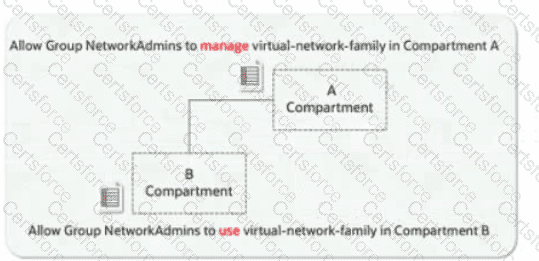
According to OCI IAM policy inheritance, how does the OCI IAM policy engine resolve the permissions for a user attempting to perform an operation that requires 'manage' permissions in the child compartment?
"A business has a hybrid cloud infrastructure with Oracle Linux instances running in OCI and on-premises. They want to reduce the amount of bandwidth used when patching systems.
Which component of OS Management Hub can help to reduce the bandwidth usage for patching?
"Your company is building a highly available and secure web application on OCI. Because of increasing malicious web-based attacks, the security team has mandated that web servers should not be exposed directly to the Internet.
How should you architect the solution while ensuring fault tolerance and security?